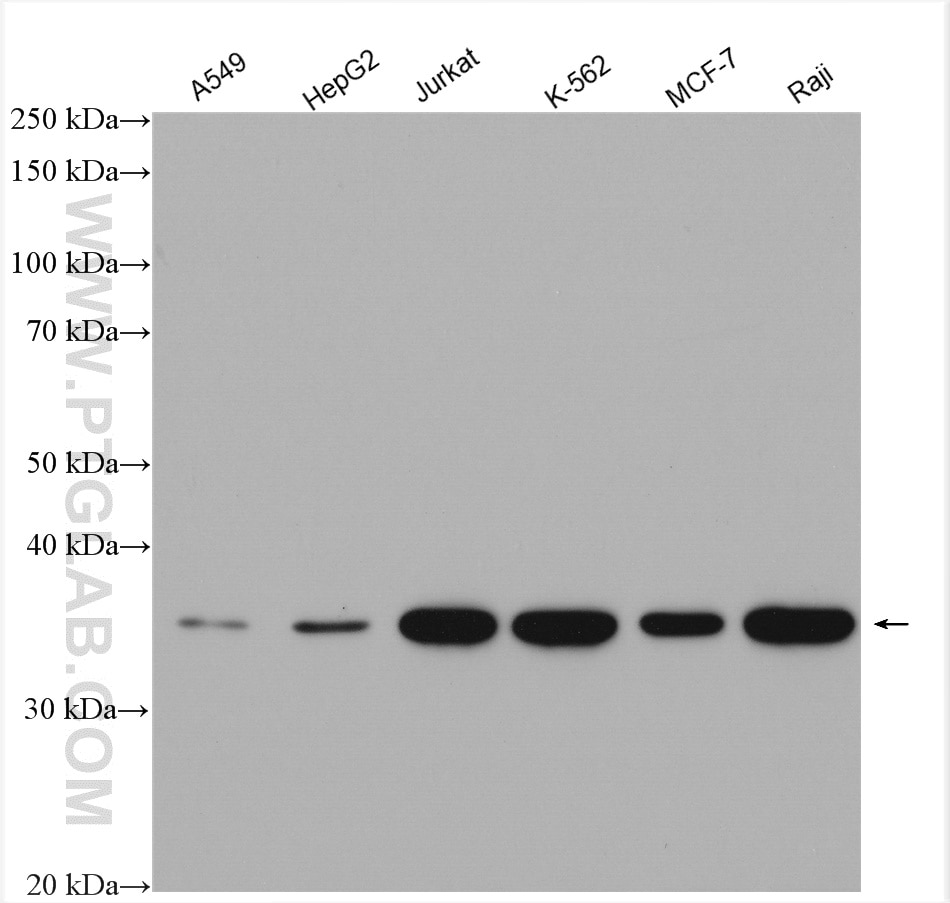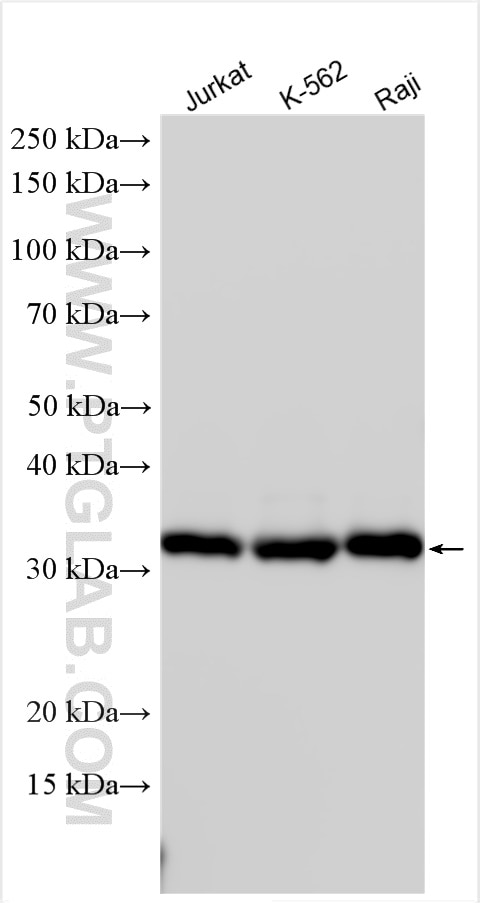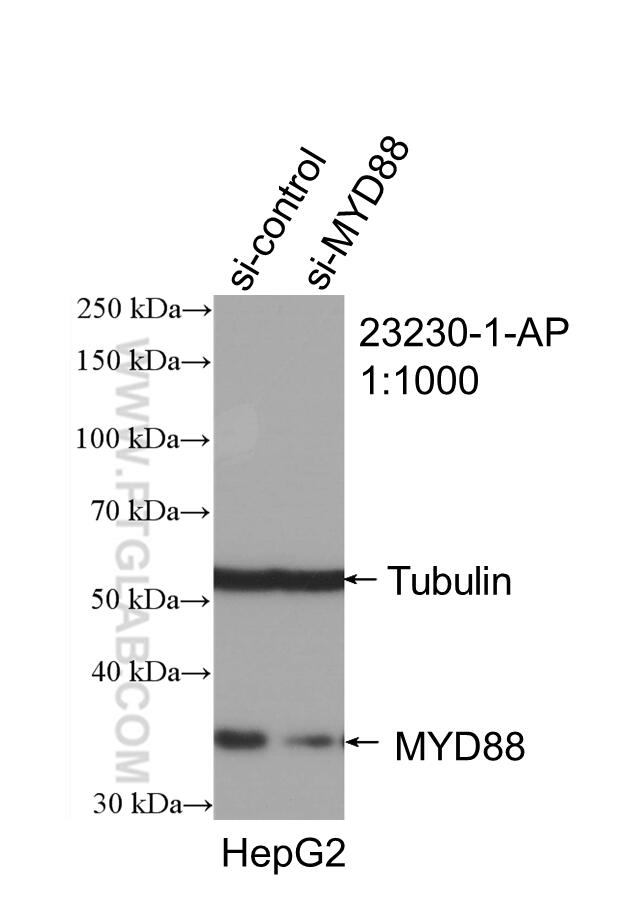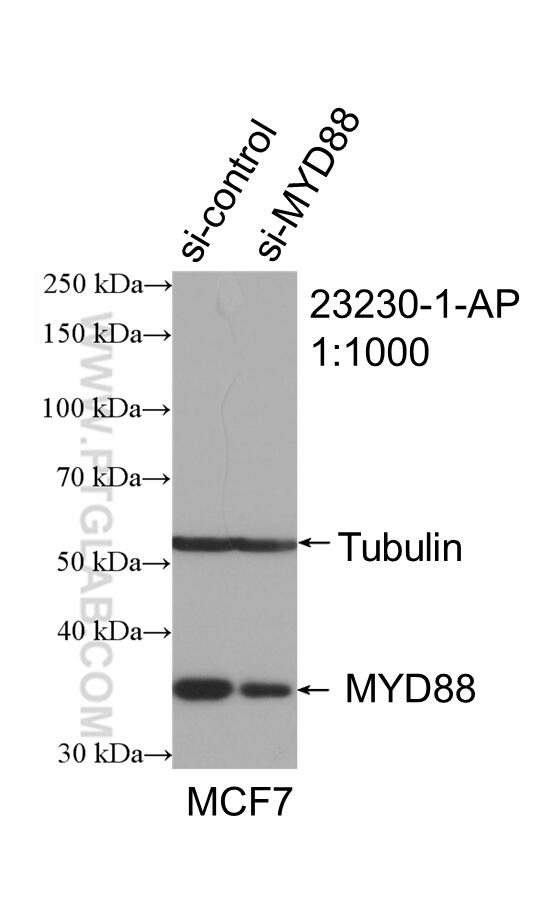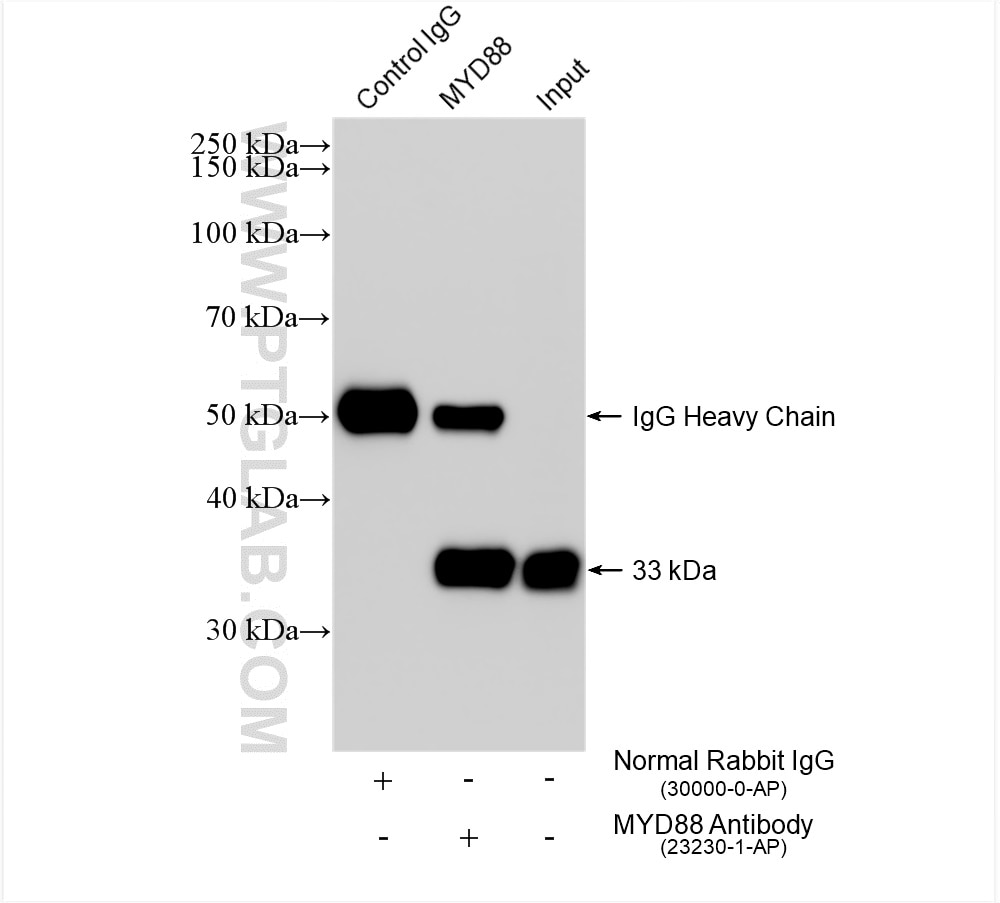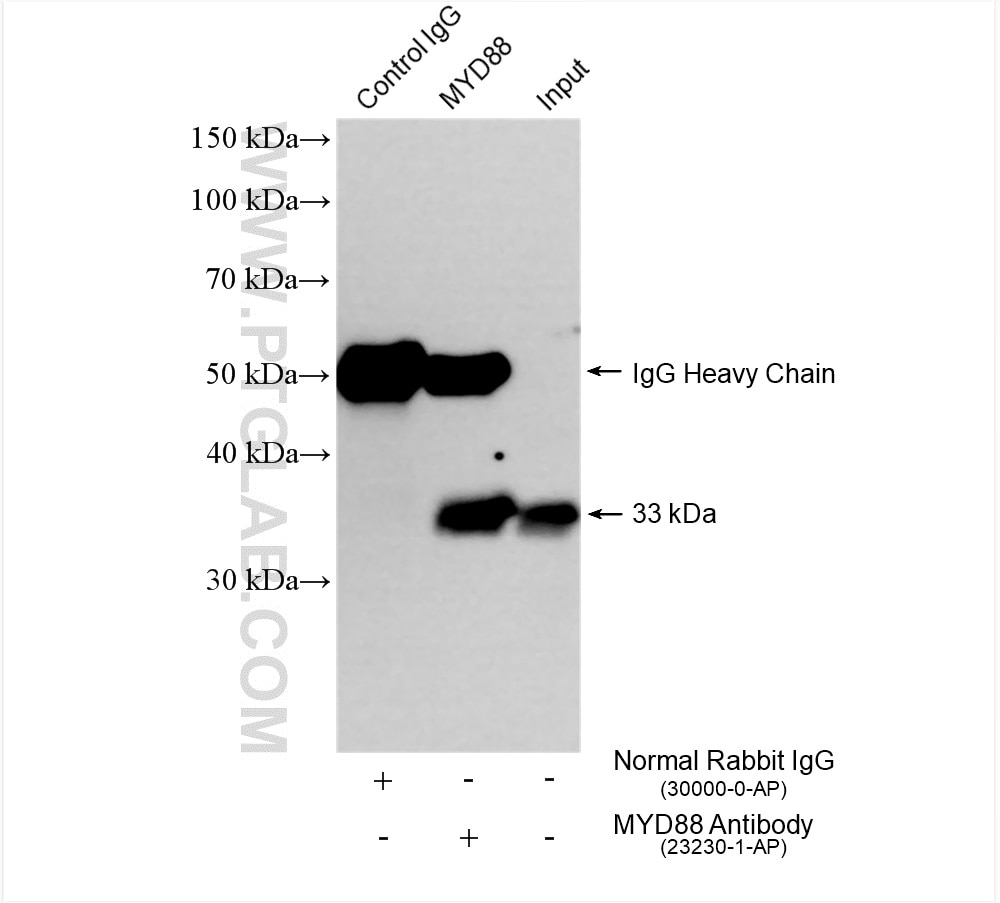- Phare
- Validé par KD/KO
Anticorps Polyclonal de lapin anti-MYD88
MYD88 Polyclonal Antibody for WB, IP, ELISA
Hôte / Isotype
Lapin / IgG
Réactivité testée
Humain et plus (6)
Applications
WB, IHC, IF, IP, CoIP, ELISA
Conjugaison
Non conjugué
N° de cat : 23230-1-AP
Synonymes
Galerie de données de validation
Applications testées
| Résultats positifs en WB | cellules Jurkat, cellules A549, cellules HepG2, cellules K-562, cellules MCF-7, cellules Raji |
| Résultats positifs en IP | cellules K-562, cellules A549 |
Dilution recommandée
| Application | Dilution |
|---|---|
| Western Blot (WB) | WB : 1:5000-1:50000 |
| Immunoprécipitation (IP) | IP : 0.5-4.0 ug for 1.0-3.0 mg of total protein lysate |
| It is recommended that this reagent should be titrated in each testing system to obtain optimal results. | |
| Sample-dependent, check data in validation data gallery | |
Applications publiées
| KD/KO | See 5 publications below |
| WB | See 215 publications below |
| IHC | See 12 publications below |
| IF | See 12 publications below |
| IP | See 2 publications below |
| CoIP | See 1 publications below |
Informations sur le produit
23230-1-AP cible MYD88 dans les applications de WB, IHC, IF, IP, CoIP, ELISA et montre une réactivité avec des échantillons Humain
| Réactivité | Humain |
| Réactivité citée | bovin, canin, Humain, porc, poulet, singe, duck |
| Hôte / Isotype | Lapin / IgG |
| Clonalité | Polyclonal |
| Type | Anticorps |
| Immunogène | MYD88 Protéine recombinante Ag19770 |
| Nom complet | myeloid differentiation primary response gene (88) |
| Masse moléculaire calculée | 33 kDa |
| Poids moléculaire observé | 33 kDa |
| Numéro d’acquisition GenBank | BC013589 |
| Symbole du gène | MYD88 |
| Identification du gène (NCBI) | 4615 |
| Conjugaison | Non conjugué |
| Forme | Liquide |
| Méthode de purification | Purification par affinité contre l'antigène |
| Tampon de stockage | PBS with 0.02% sodium azide and 50% glycerol |
| Conditions de stockage | Stocker à -20°C. Stable pendant un an après l'expédition. L'aliquotage n'est pas nécessaire pour le stockage à -20oC Les 20ul contiennent 0,1% de BSA. |
Informations générales
Myeloid differentiation primary response 88 (MYD88) is an adapter protein critical to the innate and adaptive immune response.
What is the molecular weight of MYD88?
The molecular weight of MYD88 is 33 kDa.
What is the cellular localization of MYD88?
The subcellular localization of MYD88 is largely confined to the cytoplasm as condensed forms or aggregated structures.
What is the role of MYD88 in the IL-1R signaling pathway?
MYD88 plays a major role in the inflammatory signaling pathways downstream of Toll-like receptor (TLR) and interleukin-1 receptor (IL-1R) families. MYD88 links these receptors to IL-1R-associated kinases (IRAK), such as IRAK1 and IRAK2, via protein-protein interactions. The C-terminal TIR domain of MYD88 mediates the interaction with the receptors, whereas the N-terminal death domain of MYD88 associates with IRAK family members (PMID: 25580251). MYD88 acts via its intermediate domain to phosphorylate and thus activate IRAK1, IRAK2, IRF7, and TRAF6 to trigger NF-kappa-B signaling and cytokine secretion as part of the inflammatory response (PMID: 19679662).
What is MYD88's involvement in disease?
Defects in MYD88 due to deficiency of the protein leads to recurrent pyogenic bacterial infections, including invasive pneumococcal disease. Patients usually die between 1 and 11 months of age, but surviving patients are otherwise healthy with normal resistance to other microbes (PMID: 18669862). Mutations in the MYD88 gene also lead to the development of cancers such as lymphoma (PMID: 21179087) and some autoimmune disorders like ulcerative colitis (PMID: 24189845).
Protocole
| Product Specific Protocols | |
|---|---|
| WB protocol for MYD88 antibody 23230-1-AP | Download protocol |
| IP protocol for MYD88 antibody 23230-1-AP | Download protocol |
| Standard Protocols | |
|---|---|
| Click here to view our Standard Protocols |
Publications
| Species | Application | Title |
|---|---|---|
Adv Mater Manganese@Albumin Nanocomplex and Its Assembled Nanowire Activate TLR4-Dependent Signaling Cascades of Macrophages | ||
Mol Cell CPT1A induction following epigenetic perturbation promotes MAVS palmitoylation and activation to potentiate antitumor immunity
| ||
Mol Cell Serine synthesis sustains macrophage IL-1β production via NAD+-dependent protein acetylation | ||
Adv Sci (Weinh) OR11H1 Missense Variant Confers the Susceptibility to Vogt-Koyanagi-Harada Disease by Mediating Gadd45g Expression | ||
Gut Microbes Fusobacterium nucleatum promotes esophageal squamous cell carcinoma progression and chemoresistance by enhancing the secretion of chemotherapy-induced senescence-associated secretory phenotype via activation of DNA damage response pathway | ||
Nucleic Acids Res The N6-methyladenosine RNA-binding protein YTHDF1 modulates the translation of TRAF6 to mediate the intestinal immune response. |
Avis
The reviews below have been submitted by verified Proteintech customers who received an incentive for providing their feedback.
FH Rouba (Verified Customer) (07-05-2022) | Antibody was diluted to the 1/100 in blocking solution and incubated ON at 4 degrees celcius
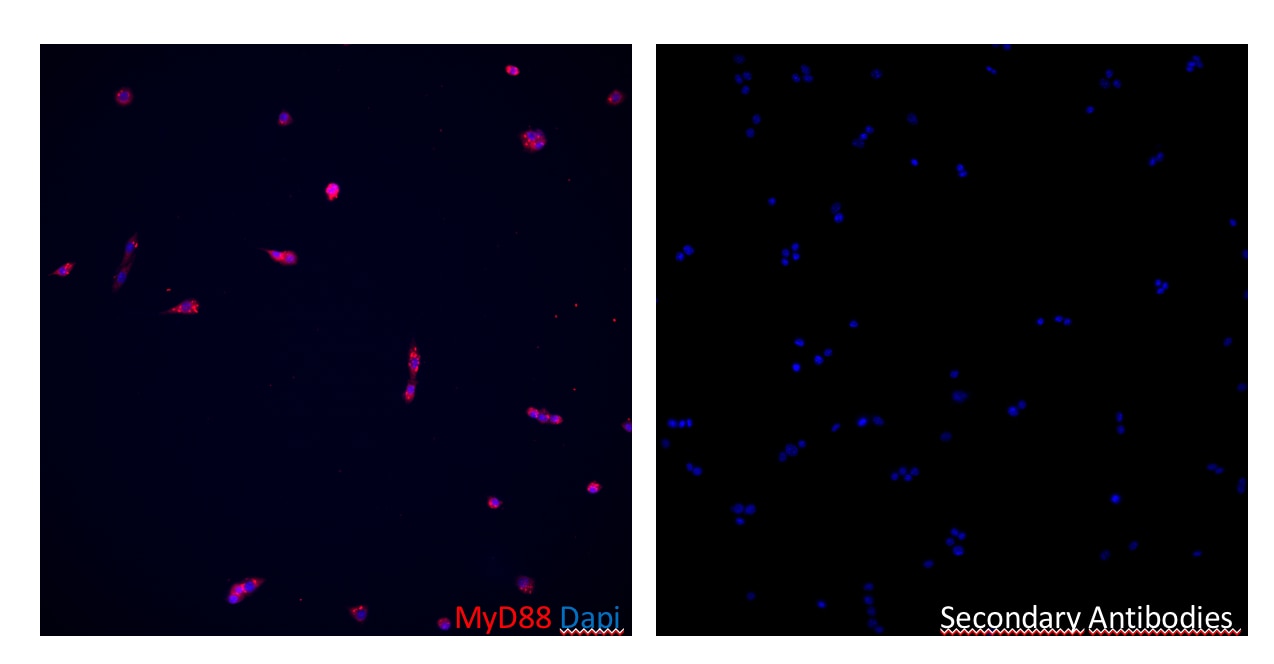 |
FH Cassand (Verified Customer) (10-22-2021) | Nice antibody works good.
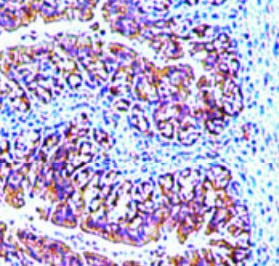 |
